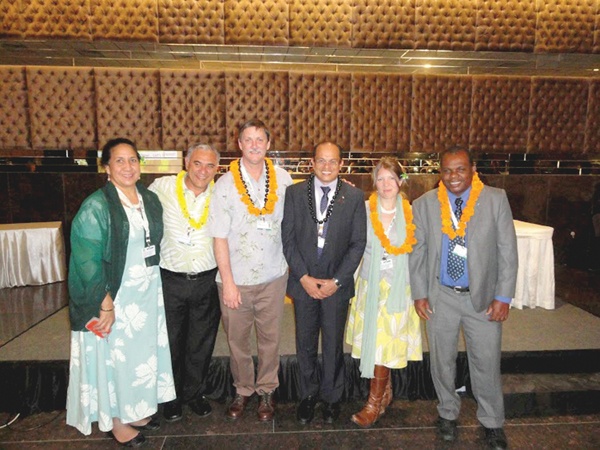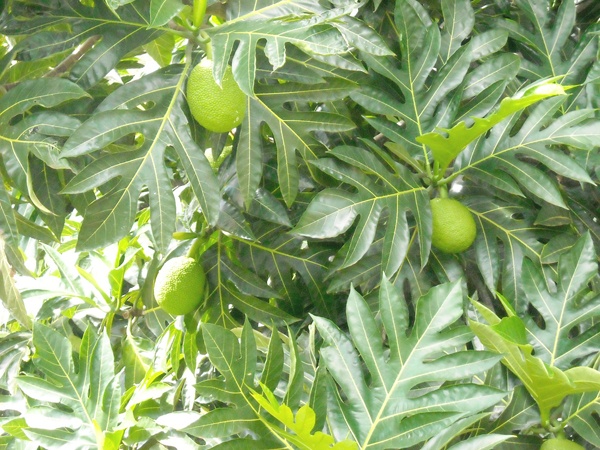KALAHEO — One of the greatest challenges facing the National Tropical Botanical Garden in Kalaheo is the need for increased social capital. “We want our community to fully understand and value who we are,” said Chipper Wichman of his goal
KALAHEO — One of the greatest challenges facing the National Tropical Botanical Garden in Kalaheo is the need for increased social capital.
“We want our community to fully understand and value who we are,” said Chipper Wichman of his goal to build awareness of the need to preserve tropical plants.
Wichman, who is the CEO of the National Tropical Botanical Garden (NTBG), recently returned from a trip to India with a delegation from Hawai‘i led by department of Land and Natural Resources Chairman William J. Aila Jr.
The NTBG was founded in the 1950s by a group of visionaries in a time when the word “biodiversity” didn’t exist, Wichman said, adding, “The extinction crisis wasn’t on anyone’s radar.”
The group was granted a congressional charter as a privately funded nonprofit organization with a national and international need.
“It’s rather amazing that an organization having an impact on the world is headquartered here, in downtown Kalaheo,” said Wichman, who became CEO in 2003.
However, the facility is often overlooked on Kaua‘i because much of its funding and board members come from the Mainland.
That said, Wichman would like to see “5,000 or 10,000 card-carrying members” of the NTBG here on Kaua‘i. He notes that while it won’t mean a huge financial benefit to the organization compared to the millions of dollars in operating expenses the NTBG spends annually, there is a strong need to build social capital and support from the community. “You can’t put a price on that,” he said.
“We’re working to become a stronger community resource, not just an international resource,” Wichman said. “And this whole McBryde Garden expansion is a great example of that.”
The success of two expansion projects in the McBryde Garden depends, Wichman said, “on the community’s understanding, participation and support of them.”
Wichman said the NTBG currently hosts the largest collection of federally listed endangered species in the world under the Endangered Species Act.
“The register includes everything from owls to bison to eagles to plants. If you look at something like the Native Hawaiian flora, roughly half of the plants native to the Hawaiian Islands have some level of threat associated with them,” said Wichman.
“Growing in our living collection, there is no garden or location in the world gathered together in a collection than we have.”
The organization is working hard to save these species.
“Conservation is an area we have specialized in and we’ve done pretty well at it,” Wichman said of NTBG’s work. “What I believe is important is that we conduct our work not just as an insular inward looking” effort to save plants on the island, but also while looking at the global picture.
The United Nations (UN) has declared the world is in a “Decade of Biodiversity.” This effort started 20 years ago at the 1992 Earth Day in Rio de Janiero, Wichman said. At the time, the UN launched an international effort titled the Convention for Biodiversity (CBD) that since been codified by 160 countries stating that the world needs to save biodiversity.
“The CBD set aggressive, but essential, targets,” said Wichman. But by 2010, the group had failed to meet even one target. “We may reach a tipping point where it is impossible to recover.”
Wichman said these losses might include potential medications, crops, even answers for energy.
To counter these losses, Wichman said, “The NTBG should be a leader in meeting international targets.”
As part of that goal, Wichman recently headed to South Korea for the International Union for Conservation of Nature’s World Conservation Congress, which meets every four years.
Wichman said he hopes Hawai‘i will host the 2016 World Conservation Congress, but notes the decision is up to President Barack Obama.
In South Korea, Wichman led a delegation of 40 people including Lt. Gov. Brian Schatz for a series of high level symposium.
From there, Wichman traveled to a NTBG board meeting in Scotland, followed by a trip to Florida before being called on by Hawai‘i’s Department of Land and Natural Resources (DLNR) Chairman William J. Aila Jr. to join him in highlighting Hawai‘i’s international leadership in green growth at the Island Summit held at the United Nations’ Convention on Biological Diversity, Conference of the Parties in mid-October.
At the event in Hyderabad, India, Wichman joined Aila in presenting “Island Innovations: Celebrating Bright Spots, Leadership and Successes in Island Conservation and Sustainable Livelihoods.”
“At the very front-line of all of these issues are islands,” said Wichman of the Bright Spots gathering. “Islands have a limited amount of resources. They are on the front-line of global climate change at sea level rise. They have greater pressures on their resources because of their isolation and as a result, they are like the canary in the coal mine.”
Sustainability must start in a smaller scale and evolve to the global stage.
“Hawai‘i is the most isolated population on the planet, and we depend on imports for 80 to 90 percent of our energy and food. We must take action to build a more sustainable and self-sufficient economy for our people,” Aila said in a press release.
Hawai‘i’s delegation highlighted the state’s commitments to renewable energy and a sustainable economy as outlined in Gov. Neil Abercrombie’s New Day Plan, DLNR’s “Rain Follows the Forest” watershed initiative, Hawai‘i’s Clean Energy Initiative, Hawai‘i 2050 Sustainability Plan, county sustainability initiatives and local grassroots community efforts.
The Island Innovations event was organized by the Global Island Partnership (GLISPA) and co-hosted by the governments of the Seychelles Islands and India to promote actions for island conservation and sustainable livelihoods by inspiring leadership, catalyzing commitments and facilitating collaboration.
Working with Hawai‘i leaders, GLISPA helped form the Hawai‘i Green Growth Initiative (HGG) in 2011.
“HGG’s mission is to bring Hawai‘i leaders from energy, food and the environment together to achieve sustainability in Hawai‘i and serve as a model for integrated green growth,” said Wichman. “Hawai‘i’s participation in the Island Summit is an unprecedented opportunity to represent our country’s commitment to island conservation and sustainability.”
The Hawai‘i delegation spoke with global representatives about Hawai‘i’s collaborative and cultural-based efforts to build a green-blue economy with ambitious targets to increase renewable energy, local food production, and protection of natural resources while creating a more diverse economy with green jobs, according to a press release.
“The Hawai‘i Green Growth Initiative is important to all islands because we need to build sustainable economies for our environment and our communities,” said Rolph Payet, minister for Environment and Energy for the Seychelles Islands. “We welcome Hawai‘i to the global island family and look forward to learning from one another.”
“As islands, we understand that the challenges facing islands and our planet are linked, and we must solve them together,” Aila said. “Our economic future depends on caring for our environment mauka to makai.”
• Laurie Cicotello, business writer, can be reached at 245-3681 (ext. 257) or business@thegardenisland.com



